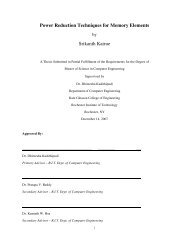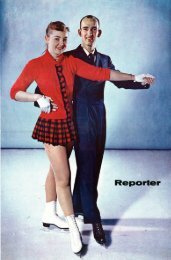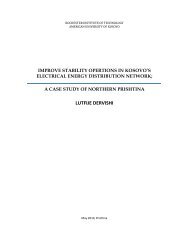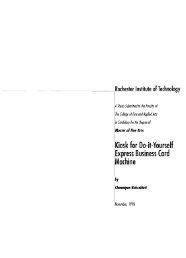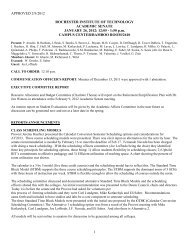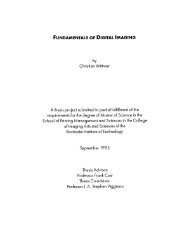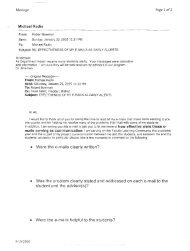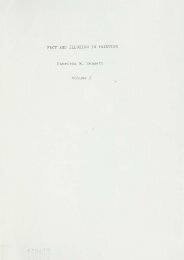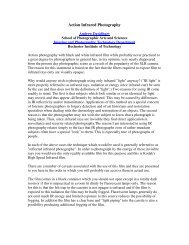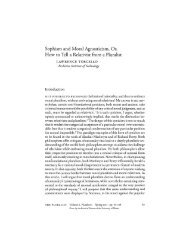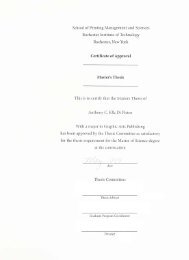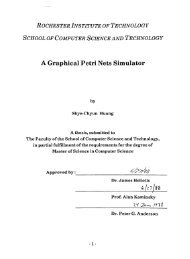Self-Portrait as the Allegory of Painting (La Pittura) Maureen Lester ...
Self-Portrait as the Allegory of Painting (La Pittura) Maureen Lester ...
Self-Portrait as the Allegory of Painting (La Pittura) Maureen Lester ...
You also want an ePaper? Increase the reach of your titles
YUMPU automatically turns print PDFs into web optimized ePapers that Google loves.
Arguments have also been proposed that Artemisia's portrayal <strong>of</strong> herself <strong>as</strong> <strong>Painting</strong>,<br />
with a prominent chain and unusually small m<strong>as</strong>k <strong>as</strong> seen in <strong>La</strong> <strong>Pittura</strong>, w<strong>as</strong> intended to<br />
represent <strong>the</strong> artist <strong>as</strong> serving her current patron, and that she no doubt employed herself <strong>as</strong> <strong>the</strong><br />
model, albeit in a highly original f<strong>as</strong>hion (Christiansen and Mann 420). The set-up required to<br />
paint a self-portrait in <strong>the</strong> way <strong>of</strong> <strong>La</strong> <strong>Pittura</strong> w<strong>as</strong> difficult, requiring two mirrors, and would seem<br />
to support <strong>the</strong> bo<strong>as</strong>ting found in letters to Don Antonio Ruffio in Sicily, in which she wrote<br />
statements such <strong>as</strong> "And I will show our Most illustrious Lordship what a woman can do," and<br />
"You will find <strong>the</strong> spirit <strong>of</strong> Caesar in this soul <strong>of</strong> a woman" (420).<br />
Besides <strong>the</strong> issue <strong>of</strong> <strong>the</strong> actual image, questions <strong>of</strong> self-portraiture arise over how <strong>the</strong><br />
piece w<strong>as</strong> referred to in inventories. In <strong>the</strong> inventory <strong>of</strong> 1687-88 <strong>of</strong> <strong>the</strong> English Royal Collection<br />
<strong>the</strong>re is two references "Ar<strong>the</strong>misia gentilesco. Done by her selfe," and "Pintura A painteigne"<br />
(274). Levey presumes that <strong>the</strong>se attributions were for <strong>the</strong> same image, representing a self-<br />
portrait and <strong>the</strong> <strong>Allegory</strong> <strong>of</strong> <strong>Painting</strong>, however, no where else does ano<strong>the</strong>r painting appear twice<br />
in <strong>the</strong> inventory (274). Thus Bissell believes <strong>the</strong>re were in fact two separate paintings, meaning<br />
<strong>La</strong> <strong>Pittura</strong> is not a self-portrait.<br />
Ano<strong>the</strong>r issue opened for debate is when and where this painting w<strong>as</strong> created, <strong>as</strong> well <strong>as</strong><br />
for whom w<strong>as</strong> it originally intended. The provenance <strong>of</strong> <strong>La</strong> <strong>Pittura</strong> cannot be traced back earlier<br />
than 1649, when it w<strong>as</strong> already in England (Garrard 110). It is here that it is first mentioned in<br />
<strong>the</strong> inventory collections <strong>of</strong> Charles I (110). However, many have connected <strong>the</strong> piece with one<br />
<strong>of</strong> Artemisia's principal Italian patrons, Roman scholar C<strong>as</strong>siano dal Pozzo (110). Three letters<br />
written from Naples in 1639 to C<strong>as</strong>siano mention a promise to deliver a self-portrait he had<br />
requested (110). No fur<strong>the</strong>r mention <strong>of</strong> a self-portrait for C<strong>as</strong>siano occurs until 1637, when<br />
Artemisia wrote to him that among <strong>the</strong> paintings she proposed to ship to Rome, pending a reply,<br />
375



